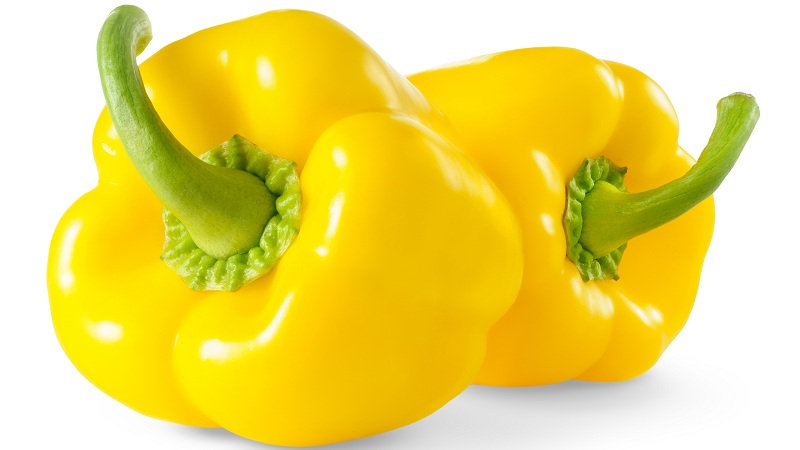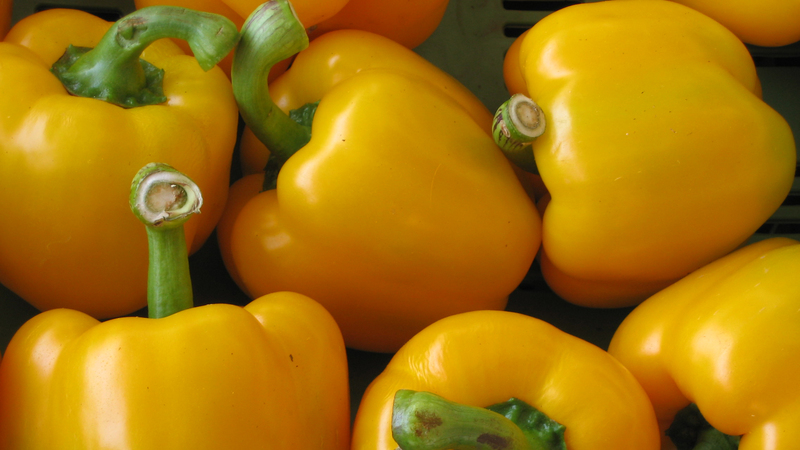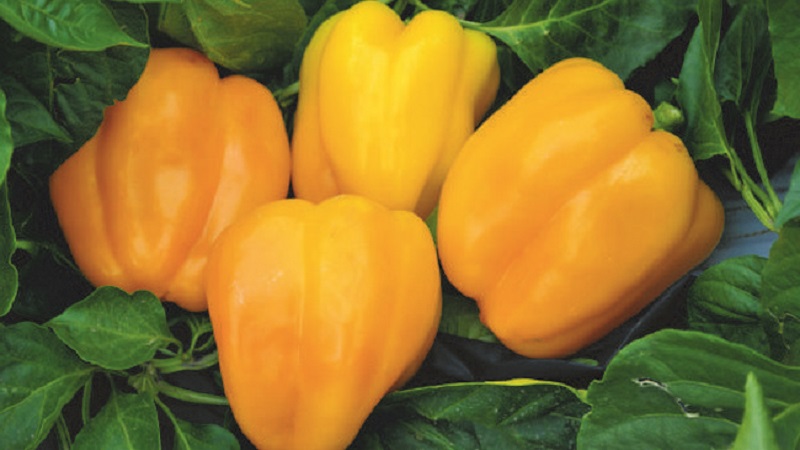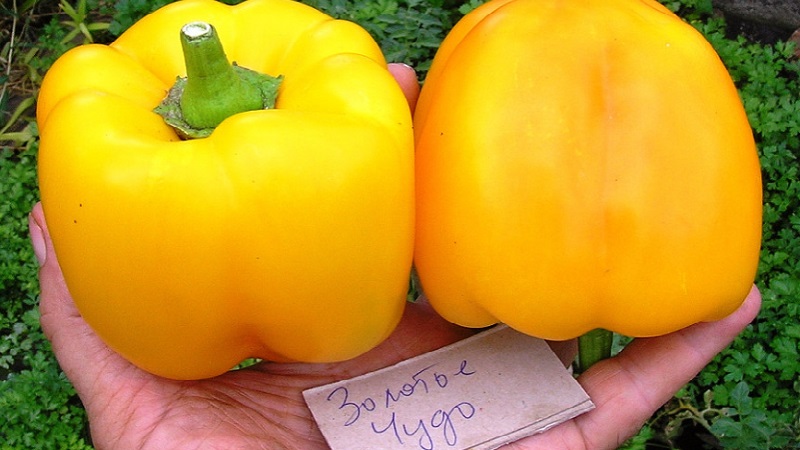Characteristics and description of varieties of yellow pepper
Red, yellow, green - the variety of sweet pepper varieties pleases the eye in the garden beds and store counters. This vegetable comes from America, and the Bulgarians brought it to Russia, due to which the name "Bulgarian pepper" was assigned to it. Each color of pepper was bred by breeders not only for the sake of beauty on the table - it has certain benefits for the body.
The content of the article
The chemical composition and trace elements of pepper
Bell pepper is a low-calorie vitamin vegetable. It contains vitamins B1, B2, B9, PP, H, and the content of vitamin C (200 mg) in pepper covers the daily intake.
In addition to vitamins, 100 g of fruit contains:
- water - 91.9 g;
- carbohydrates - 4.9 g;
- proteins - 1.3 g;
- fats - 0.1 g;
- fiber - 1.9 g;
- organic acids - 0.1 g;
- ash compounds - 0.6 g.

What is the peculiarity of yellow pepper and how it differs from the rest
Each vegetable variety differs not only in color and taste, but also in certain benefits. Nature has hidden vitamins and valuable compounds behind each color. What is the difference between yellow pepper and fruits of a different color?
Features:
Varieties of yellow color have excellent taste, high yield (7-14 kg per 1 m²) and relative exactingness to growing conditions.
Under unfavorable climatic conditions, early varieties are planted in the open ground, and mid-season and late ones - in a greenhouse.
Vitamins
The yellow color of the pepper indicates a high content of rutin and beta-carotene in them. In addition, the vegetable contains vitamin C, potassium, phosphorus.
Why these components are useful:
- rutin strengthens the walls of blood vessels and makes them more elastic;
- vitamin C helps fight colds;
- beta-carotene, or provitamin A, lowers the level of cholesterol in the body, prevents diseases of the cardiovascular system, protects cells from the effects of radicals;
- potassium helps to strengthen bone and vascular systems;
- phosphorus is important for cell growth and bone strength.
This is how the yellow varieties differ from others. Their calorie content is higher than that of green and red peppers: 27.2 kcal per 100 g.
Reference. The hormone of happiness is contained in golden pepper. But unlike chocolate and banana, where this substance is also present, pepper does not add excess weight.

Benefit
It is recommended to include yellow bell peppers in the diet for people of retirement age, with atherosclerosis, heart and kidney diseases. For maximum benefits, peppers are eaten fresh as a side dish for meat dishes and in vitamin salads.
Attention! For people prone to allergic reactions (hives), doctors recommend removing all red fruits, berries and vegetables from the diet. Yellow pepper does not cause allergies.
Is sweet pepper good for everyone
Most healthy people can and should eat bell peppers. Scientists from the University of Washington in 2013 discovered anatabine in the vegetable, which stimulates the brain receptors and protects nerve fibers from damage. If older people regularly eat Bulgarian vegetables, their risk of developing Parkinson's disease will be reduced by 30%.
Despite all the beneficial properties, doctors do not recommend eating pepper:
- during an exacerbation of chronic diseases;
- people with digestive disorders - gastritis of various acidity, diseases of the liver and biliary tract;
- persons with increased nervous excitability;
- with hypotension, epilepsy and coronary heart disease.
Early ripening varieties
Early harvest ready to harvest within 75-100 days after germination. In central Russia, these peppers are grown by seedlings without picks.

The best varieties and hybrids of yellow bell peppers:
- Orange Mango F1 - a promising hybrid that ripens in 60 days. Differs in large orange fruits weighing 200 g, unpretentiousness and resistance to top rot.
- Orange lion - hybrid, ready to harvest 100 days after planting. Plant height - 100-120 cm.Differs in amicable and abundant the formation ovaries on the bush. Productivity is high - 8-9 kg / m².
- Hungarian miracle - early bitter pepper that tolerates cold. Recommended for outdoor and indoor cultivation. The bush grows up to 50 cm, sprinkled with yellow rounded peppers, each weighing 50 g. Hot yellow Hungarian pepper, according to gardeners and housewives, is not suitable for blanks, it is used fresh, to decorate dishes.
- Yellow cream... The variety ripens in 60 days. The plant forms a tall shrub up to 1 m with a spreading crown covered with small yellow spherical peppers, resembling small plums in size. The mass of peppers is 20 g.
- Giant yellow f1 - pepper with a powerful and high stem up to 110 cm tall. Fruiting in 110-130 days after planting. Gardeners recommend tying up spreading plants or using trellises so that the bushes do not break. Fruit weight - up to 300 g, length - up to 20 cm.
Mid-season varieties
Medium-ripening varieties in regions with cold and short summers are grown in greenhouses and greenhouses. The general growing season from the moment of germination is 116-140 days. Seeds for seedlings are sown in February, and in March, plants are dived into individual pots.

Popular mid-season varieties:
- Yellow bull - one of the most famous mid-season varieties. The fruits are large, weighing 200 g, 20 cm long, fleshy, conical. The fruit has 3-4 distinct lobes. The crop is recommended for film and heated greenhouses. Average yield - 9-14 kg / m².
- Golden Rain - plant up to 80 cm high. The variety is intended for indoor use. The crop ripens in 116 days. Fruits of lemon-yellow color, weighing 50-60 g, flat-round shape, sweet. The aroma is weak.
- Yaroslav - a yellow vegetable with an orange-red tip and a pyramidal shape of the fruit. Plants with a height of 140 cm give a harvest for 105-110 days. Resistant to verticillium.
- Yellow elephant – Bell pepperripening in 125-130 days. Productivity - 7.2 kg / m². The bushes are not spreading. Fruits are cone-shaped, elongated, weighing 150 g, wall thickness - 6 mm. Suitable for freezing.
- Yellow miracle... The fruits are harvested after 120-125 days. The bushes grow up to 70 cm, the shoots are compactly located. Fruit weight - 80-130 g. Productivity - 5-8 kg per 1 m². Gardeners recommend planting the Yellow Miracle in illuminated areas.
Late ripening varieties
The period from germination to technical ripeness (acquiring an orange or yellow color) in late varieties is more than 140 days.
Advantages of late varieties: high keeping quality during storage (up to 3 months), transportability, large fruits.
The most popular varieties and hybrids by gardeners:
- Gold Cup. Medium-sized bush, strongly leafy. Peppers have a clear cubic shape, 10 cm in diameter and 200 g in weight.
- Yellow bell. Plants with a height of 75 cm give fruits of a rich yellow color, with a diameter of 11 cm. The walls are fleshy, juicy. The variety is resistant to viral diseases.
- Hottabych F1 - the latest hybrid for greenhouses (170 days). Peppers are curved, long, 100-120 g. As they ripen, the fruits change color from yellow to orange-red.
Conclusion
Yellow peppers are thermophilic crops that require gentle care. Most varieties and hybrids of yellow peppers are universally used in cooking. They go to salads, appetizers and main courses. Late varieties retain their presentation for a long time and are distinguished by high keeping quality.